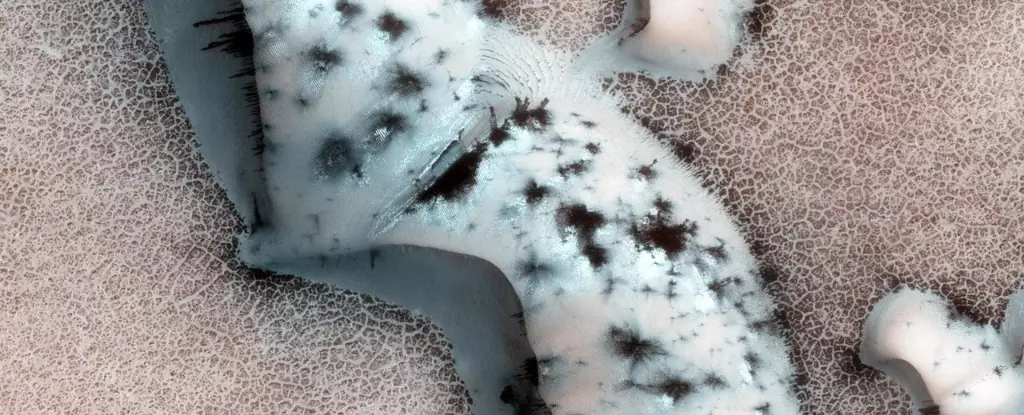Mars, often viewed as a desolate and lifeless planet, possesses a unique natural beauty that sets it apart from Earth. While our planet is teeming with vibrant life and vivid landscapes, Mars’ stark, barren terrain provides a canvas for captivating geological phenomena that intrigue scientists and enthusiasts alike. Among these phenomena are the fascinating carbon dioxide geysers, which, despite their frigid environment, offer insights into the dynamic processes occurring beneath the surface of this enigmatic world.
Despite being the fourth planet from the Sun, Mars has a remarkably thin atmosphere composed predominantly of carbon dioxide, accounting for about 95% of its gaseous composition. This tenuous atmosphere contributes to extreme temperature fluctuations, particularly during the Martian winter. As temperatures plummet, carbon dioxide in the atmosphere freezes, laying a thick layer of CO2 frost over the polar regions. This frozen substance can remain dormant for extended periods, concealing the complex processes that are taking place below.
With the arrival of spring on Mars, temperatures begin to rise gradually, allowing sunlight to penetrate the translucent layer of frozen CO2. This warm energy interacts with the ground beneath, causing the frozen gas to sublimate—transitioning from a solid state to gas without becoming liquid. This process leads to a buildup of high-pressure gas beneath the ice layer, creating a pressure cooker effect that eventually results in spectacular eruptions.
Geysers of Mars: A Spectacle of Nature
In October 2018, images captured by the High-Resolution Imaging Science Experiment (HiRISE) camera aboard NASA’s Mars Reconnaissance Orbiter revealed the awe-inspiring eruptions of these carbon dioxide geysers. These geysers are no mere dribbles—they can eject dark material that spreads across the icy surface in impressive bursts, some reaching diameters of up to 1 kilometer. The force behind these eruptions is incredible, with gas escaping at speeds reaching 160 kilometers per hour. Such vigorous activity not only reshapes the surface of Mars but also presents a stark contrast to the gentle, life-sustaining processes on Earth.
As these geysers erupt, they leave behind unique geological formations known as araneiform terrain, or “spider terrain.” These structures, which resemble the intricate patterns of spiders, emerge from the subsurface eruptions and can group together, giving the Martian landscape a wrinkled appearance. The study of these features offers a glimpse into the complex interplay of seasonal changes on Mars and the underlying physical principles driving these phenomena.
The processes that lead to the formation of Martian geysers are explained by a model proposed by scientist Robert M. Keiffer and his co-researchers. According to their theory, the seasonal CO2 ice cap creates a barrier that traps gas beneath it. As the gas accumulates and pressure builds, it eventually overwhelms the structural integrity of the ice, causing it to rupture. This release not only ejects sand-sized particles but also shapes the geological landscape by eroding channels and creating distinct dark spots reminiscent of natural art.
The beauty of these features lies not only in their visual appeal but also in the science behind their creation. Lauren McKeown from NASA’s Jet Propulsion Laboratory eloquently describes these “strange and beautiful” formations, emphasizing how they challenge our understanding of geological processes in extraterrestrial environments.
The Unique Beauty of Mars Compared to Earth
While Earth is renowned for its lush biodiversity and landscapes that have inspired countless poets and artists, Mars presents a different kind of aesthetic—a beauty defined by stark contrasts and alien landscapes. The processes that forge the Martian surface are unlike any observed on Earth, showcasing the planet’s individuality in the cosmic tapestry of our solar system. This peculiarity invites comparisons and observations that not only ignite human imagination but also inspire scientific curiosity.
Mars, with its unique carbon dioxide geysers and intricate geological features, offers a glimpse into a world shaped by powerful natural forces. As ongoing research and exploration continue to reveal the mysteries of this cold, distant planet, we are reminded of the vast diversity of beauty found within our universe. Although it may lack the vibrant life visible on Earth, Mars is undeniably a spectacle that draws us in with its haunting allure and scientific intrigue.

